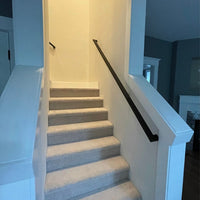How handrails in your home can save your life!
According to a study published in the American Journal of Emergency Medicine, more than a million people end up in a hospital emergency room each year for stair-related falls. Additionally, in 2019, the CDC reports that over 2,500 deaths occurred due to falls on stairs and steps.
Stair-related injuries disproportionately affect elders and children and can cause broken bones and serious head and neck-related injuries, resulting in a need for hospitalization or physical therapy. That’s why it’s important to take the necessary steps to lessen the risk of injury and ensure the safety of anyone using your staircase.
Fortunately, handrails for stairs are the number one way to prevent accidents.
Do I need a handrail?
While the choice is yours to make in your own home, handrails are a safety net everyone needs. It’s essential for anyone traversing a staircase to have something to comfortably hold on to for both safety and security. Not only can they prevent a fall, but they can also protect you and lessen any damage if a fall is already in progress.
Plus, they can provide support to the elderly and the disabled who struggle to travel up and down the stairs. In a residential home, it’s recommended to mount at least one handrail where there is not a wall to protect from falls. If there aren’t any walls, two handrails – or whichever is most convenient for you – are recommended.
If you’re deciding on installing handrails in a rental or commercial property, it’s necessary to mount two handrails, with one on each side of the stair. As there will be several types of people across all age groups and ailments using the staircase, it’s important to think ahead and provide the necessary accommodation. Insufficient accessibility and lack of any protection from injury can make you liable for any incidents on your property.
What handrail type should I buy?
There are two types of handrails. A straight handrail and a close-ended handrail.
Straight handrails are just as they sound. A simple tube, such as a metal handrail you see in industrial and commercial settings, that doesn’t curve or turn. The ending is visible and is typically capped.
Close-ended handrails typically turn at a 90-degree corner and close inside the wall. These handrails are typically safer than straight handrails as they aren’t sticking out, have a definitive ending, and won’t get caught on clothing or loose material. In some cities, like Los Angeles, close-ended handrails are mandatory according to the residential and commercial building code.
Where do I mount my handrail?
Proper locations to mount your handrail includes walls with wood stud wall framing, stair guard railings, concrete, or masonry walls.
While guidelines are different per state, handrails are typically mounted at 34-38 inches above the bottom step. It’s important to remember that the height of your wall mount railing is relational to the stairs, not to the floor.
We often use handrails throughout our daily life without even realizing it. Not just on stairways, but on walkways and inclines as well. They’re a fundamental instrument to keeping ourselves and the people around us safe. If your home, commercial, or residential property is missing handrails, be sure to install one whenever possible. They can save your life or a loved one's.
Save a life and get your handrails today with the links below
optimumrails.com
https://www.etsy.com/shop/OptimumWorks?ref=simple-shop-header-name&listing_id=1134340313
how to install wall mount handrail



